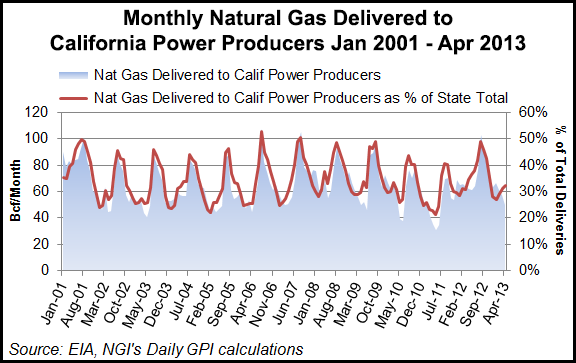Regulatory | NGI All News Access | NGI The Weekly Gas Market Report
Questions Mount on Adequacy, Spending on California Alternative Energy
While the state’s energy officials try to boost future power reliability in the absence of a major nuclear generating source, California is looking at spending up to $2.5 billion annually on efficiency and alternative energy programs.

Critics note that the efficiency and alternative energy spending would exceed what the state now provides its entire 10-campus University of California system. Meanwhile, state energy planners are fashioning a Southern California Reliability plan to make up for the loss of the 2,200 MW San Onofre Nuclear Generating Station (SONGS), 400 MW of projected annual demand growth and 6,200 MW of generating capacity set to retire in the next few years.
Efficiency and renewable energy sources cannot make up for all of the lost capacity and increased demand, so repowered or new natural gas-fired generation is expected to be tapped for at least part of the reliability plan.
On a broader basis, the politically independent legislative analyst’s office in the California legislature has recommended that state lawmakers pass legislation next year mandating that state energy planners develop a comprehensive strategy for how the state will meet its far-reaching energy efficiency and alternative energy objectives.
A recent review of the state programs found they lacked overall coordination, were hurt by duplications and are not comprehensively evaluated for their effectiveness.
In total California has spent nearly $15 billion the past 10 to 15 years on energy efficiency and alternative energy programs, the legislative analyst’s report said. It noted that the vast majority of the funding has come from the private-sector utility ratepayers. The report estimates the average gas and electric utility ratepayer contributes about $12 and $24 annually toward the energy saving programs.
“The state currently lacks a comprehensive framework that fully coordinates these activities,” the report noted. A California Energy Commission (CEC) spokesperson strongly disagreed with this characterization, citing various individual successes and the CEC’s latest annual report of its research/development programs for 2012 that was released in March this year. The CEC is likely to be tasked by state lawmakers to address the perceived shortcomings in tandem with the state regulatory commission.
The state is spending about $1 billion annually on the efficiency/alternative energy programs, but the legislative analyst’s report expects that to rise rapidly, given new state taxes and fees that are expected to contribute another $1 billion annually to the programs.
“Even as California has scaled back [state support for] education, law enforcement, and assistance to the disabled in this era of financial stress, the energy program has continued unrestrained and is expected to grow significantly in the coming years,” the Los Angeles Times reported earlier in October in a front page report raising questions about the long-standing statewide effort.
The author of the legislative analyst’s report was quoted in the report as estimating the expenditures overall climbing to $2.5 billion annually in a short time. The Times report cited energy investments going bust, utility power rates soaring and economists disputing the benefits of the multi-million-dollar programs. The long-standing use of utility ratepayer fees is also being challenged in court.
The legislative analyst’s report goes into specific details on why there are serious questions about the cost-benefit evaluations of ongoing efforts like the state’s multi-billion-dollar solar incentive program and about the level of funding and effectiveness of new efficiency/alternative energy funding from the state’s still developing carbon emission cap-and-trade auction and a new taxpayer supported fund for creating more green jobs in the state.
Citing reductions in energy consumption among the growing number of information technology hubs, or server centers, by pioneering what the CEC calls intelligent cooling, and developing a new grid monitoring system that reduces the risk of major power grid outages, the CEC defends its hundreds of millions of dollars to public interest research projects.
The research grants “foster entrepreneurship and further innovations,” the CEC spokesperson said. “Publicly funded R&D helps accelerate the path to market for clean energy technologies and reduces investment risks by funding projects the private sector is snot yet motivated to invest in. Research that removes barriers allows a future path for private-sector innovation.”
© 2024 Natural Gas Intelligence. All rights reserved.
ISSN © 1532-1231 | ISSN © 2577-9877 | ISSN © 1532-1266 |
